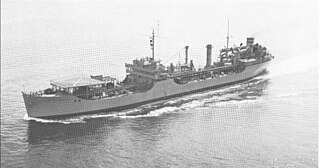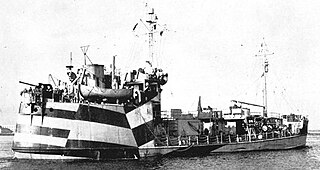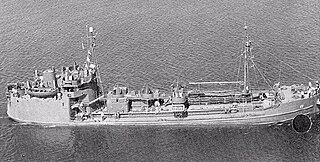
USS Susquehanna (AOG-5) was a Patapsco-class gasoline tanker in service with United States Navy from 1943 to 1946 and with the Military Sea Transportation Service from 1950 to 1959. She was scrapped in 1973.

SS Mission Capistrano was a Type T2-SE-A2 tanker built for the United States Maritime Commission during World War II. After the war she was acquired by the United States Navy as USS Mission Capistrano (AO-112). Later the tanker transferred to the Military Sea Transportation Service as USNS Mission Capistrano (T-AO-112). She was a Mission Buenaventura-class oiler and was named for San Juan Capistrano in San Juan Capistrano, California.

SS Mission Buenaventura was a Type T2-SE-A2 tanker built for the United States Maritime Commission during World War II. After the war she was acquired by the United States Navy as USS Mission Buenaventura (AO-111). Later the tanker transferred to the Military Sea Transportation Service as USNS Mission Buenaventura (T-AO-111). The lead ship in her class of fleet oilers, she was named for Mission San Buenaventura located in Ventura, California.

SS Mission San Gabriel was a Type T2-SE-A2 tanker built for the United States Maritime Commission during World War II. After the war she was acquired by the United States Navy as USS Mission San Gabriel (AO-124). Later the tanker transferred to the Military Sea Transportation Service as USNS Mission San Gabriel (T-AO-124). She was a member of the Mission Buenaventura-class oiler and was named for the Mission San Gabriel Arcángel, she was the only U.S. Naval vessel to bear the name.

USNS Mission Los Angeles (T-AO-117) was a Mission Buenaventura-class oiler that served in the United States Navy. The ship was originally intended as USS Conecuh (AO-103) for the U.S. Navy but her acquisition was canceled. The ship, a Type T2-SE-A3 tanker, was completed as SS Mission Los Angeles and delivered after the end of World War II. The tanker was acquired by the U.S. Navy in 1948 as USS Mission Los Angeles (AO-117), but was transferred to the Military Sea Transport Service upon its creation in 1949. The ship was named for Nuestra Señora Reina de los Angeles Asistencia, she was the only U.S. Naval Vessel to bear the name.

USNS Mission Santa Ana (T-AO-137) was a Mission Buenaventura-class oiler that served in the United States Navy. The ship was originally intended as USS Concho (AO-102) for the U.S. Navy but her acquisition was canceled. The ship, a Type T2-SE-A3 tanker, was completed as SS Mission Santa Ana and delivered after the end of World War II. The tanker was acquired by the U.S. Navy in 1948 as USS Mission Santa Ana (AO-137), but was transferred to the Military Sea Transport Service upon its creation in 1949. The ship was named for the Santa Ana Estancia, she was the only U.S. Naval Vessel to bear the name.

USS Wacissa (AOG-59) was a Patapsco-class gasoline tanker delivered to the United States Navy in 1946. She directly put in reserve and reactivated for service with the Military Sea Transportation Service between 1952 and 1956. In 1957, she was transferred to the United States Air Force. Shortly thereafter she was again transferred to Canada. She was finally scrapped in 1964.

USS Escambia (AO-80) was the lead ship of her subclass of the Suamico class of fleet oilers acquired by the United States Navy for use during World War II. She had the dangerous, but necessary task of providing fuel to vessels in combat and non-combat areas primarily in the Pacific Ocean. For her valiant efforts, she received five battle stars during the war.

USS Agawam (AOG-6) was a Patapsco-class gasoline tanker acquired by the U.S. Navy for the dangerous task of transporting gasoline to warships in the fleet, and to remote Navy stations.

USS Calamus (AOG-25) was a Mettawee-class gasoline tanker acquired by the U.S. Navy for the dangerous task of transporting gasoline to warships in the fleet, and to remote Navy stations.
USS Narraguagas (AOG-32) was a Mettawee-class gasoline tanker acquired by the U.S. Navy for the dangerous task of transporting gasoline to warships in the fleet, and to remote Navy stations.

USS Ontonagon (AOG-36) was a Mettawee-class gasoline tanker acquired by the U.S. Navy for the dangerous task of transporting gasoline to warships in the fleet, and to remote Navy stations.

USS Ponchatoula (AOG-38) was a Mettawee-class gasoline tanker acquired by the U.S. Navy for the dangerous task of transporting gasoline to warships in the fleet, and to remote Navy stations.
USS Yacona (AOG-45) was a Mettawee-class gasoline tanker acquired by the U.S. Navy for the dangerous task of transporting gasoline to warships in the fleet, and to remote Navy stations.

USS Mattabesset (AOG-52) was a Patapsco-class gasoline tanker in service with the United States Navy from 1945 to 1968. She was scrapped in 1969.
USNS Tonti (T-AOG-76) was a T1 tanker type, Tonti-class gasoline tanker, in operation for the United States Navy from 1948 through 1960. She was originally constructed as MS Tavern for the United States Maritime Commission at the end of World War II, and intended for delivery to the United Kingdom under the terms of Lend-Lease. Although her construction was suspended in August 1945 after the war's end, the ship, renamed Tonti after an early explorer of North America, was completed in December 1945. From June 1948 to July 1960, the tanker was operated by a private company on behalf of the U.S. Navy. After being laid up in 1960, the ship was transferred to Colombia in January 1965. As ARC Mamonal (BT-62), she served the Colombian Navy until 1975, when she was scrapped.
USNS Rincon (T-AOG-77) was a T1 tanker type, Rincon-class gasoline tanker, in operation for the United States Navy from 1950 through the 1970s. She was originally constructed as MS Tarland for the United States Maritime Commission at the end of World War II, and intended for delivery to the United Kingdom under the terms of Lend-Lease. Completed in October 1945, she was delivered to the Army Transport Service of the United States Army under the name USAT Rincon. Transferred to the U.S. Navy in 1950, she transported gasoline during the Korean War, earning two battle stars in the process. After service extending into the 1970s, the ship was transferred to South Korea in February 1982. As ROKS So Yang (AOG-55), she served the South Korean Navy until the late 1990s, when she was returned to the United States. She was struck from the U.S. Naval Vessel Register on 23 October 1998.

The T1 tanker or T1 are a class of sea worthy small tanker ships used to transport fuel oil before and during World War II, Korean War and Vietnam War. The T1 tanker classification is still in use today. T1 tankers are about 200 to 250 feet in length and are able to sustain a top speed of about 12 knots. The hull designation AO is used by the US Navy to denote the ship is a T1 oil tanker and AOG that the T1 is a gasoline tanker. The small size allows the T1 to enter just about any sea port or to anchor around a small island, this was very useful during the Pacific War. The T1 tanker can carry about 48,000 to 280,000 bbls. Some T1 tankers were used to transport goods other than oil, a few were used for black oil-crude oil, diesel, chemicals and rarely bulk cargo like grain. T1 tankers are also called liquid cargo carriers. The T1 tanker has about a 6,000 to 35,000 deadweight tonnage (DWT) of cargo. The small size also gives the ships short turn around time for repair, cleaning, loading and unloading. A T1 tanker carrying dirty cargo, like crude oil needs a few weeks of labor to clean before carrying clean cargo. Most T1 ships during World War II were named after major oil fields. T1 tankers are operated by the US Navy, War Shipping Administration and United States Maritime Commission. Some T1s were loaned to England in the Lend-Lease program for World War II, after the war most were returned to the US. After World War II many of the T1 ships were sold to for civilian use. Each T1 had emergency life rafts on the boat deck. The ships had cargo booms and piping to load and unload fuel. During war time the T1 are armed for protection with deck guns. A typical ship may have one single 3"/50 dual purpose gun, two 40 mm guns and three single Oerlikon 20 mm cannon. A T1 at war time normally had a crew of 38 and up to 130. If operating as a United States Merchant Marine ship, the crew would be a mix of civilian Merchant Marines and United States Navy Armed Guards to man the guns.

USS Peconic (AOG-68), was a type T1 Klickitat-class gasoline tanker built for the US Navy during World War II. She was named after the Peconic River, in New York.














